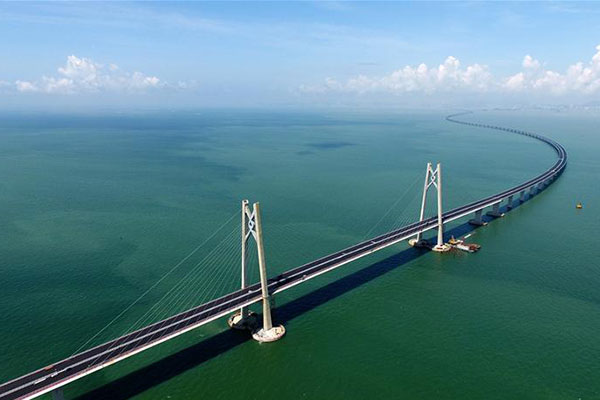
Photo taken on June 6, 2017 shows the Hong Kong-Zhuhai-Macao Bridge under construction. Major work on the 55-km-long Hong Kong-Zhuhai-Macao Bridge, the world’s longest sea bridge, has passed authorities’ evaluation. The huge project has been considered an engineering wonder and a magnificent feat of sci-tech innovation. [Photo/Xinhua]
The technologies deployed in the construction of the Hong Kong-Zhuhai-Macao Bridge (HKZM) could build the foundation for Chinese enterprises to “go global” and participate in the Belt and Road Initiative, said Su Quanke, chief engineer of the HZMB Authority on March 15.
Also a member of the National Committee of the Chinese People’s Political Consultative Conference (CPPCC), Su told the press before the closing meeting of the first session of the 13th CPPCC National Committee in Beijing that China has entered the world’s leading rank in sea bridge engineering after the completion of the HKZM Bridge.
The core technologies of the bridge, including rapid building of artificial islands and connections using underwater tunnels, have helped Chinese companies “go global”, Su said.
He told China Daily in an exclusive interview earlier that some mainland factories involved in the HZMB production line had received orders from the United States, Norway and Serbia for bridge projects.
Also on March 15, officers from the Macao Special Administrative Region were posted at the Macao checkpoint of the long-awaited HMZB, marking another step toward the grand opening of the bridge in the second quarter of 2018.
Upon the State Council’s approval, a handover ceremony of the Macao boundary crossing facility on an artificial island took place between officials of Guangdong and Macao at midnight of March 14.
Macao SAR government officers from customs, police, firefighters, healthcare and transport departments started testing and operation of the facilities after the ceremony.
The 55-kilometer-long bridge, which started construction in 2009, is expected open in May or June. It connects Hong Kong in the East of the Pearl River Estuary with Macao and Zhuhai in the west, shortening the commute between Hong Kong and Zhuhai from four hours to less than an hour once open.
As the first infrastructure project built and managed jointly by the governments of Guangdong province, Hong Kong and Macao, it has established models and mechanisms for co-construction, co-management and dispute settlement among the three places, and cultivated a large number of professional talents, said Su.
It lends great value for future cooperation in co-construction projects, as well as in advancing the development of the Guangdong-Hong Kong-Macao Greater Bay Area under the “one country, two systems” principle, Su added.
Su disclosed that big data and artificial intelligence will be used in the operation and maintenance of the bridge, and now the authorities are working on relaxing measures such as the cross-boundary traffic policy to improve the efficiency of the use of the bridge.
